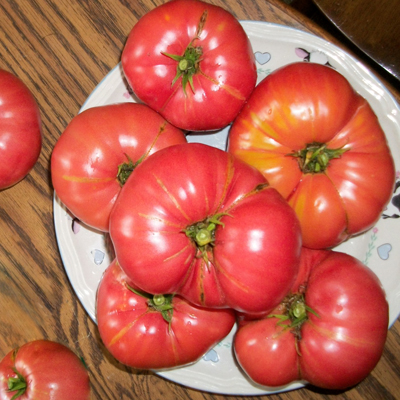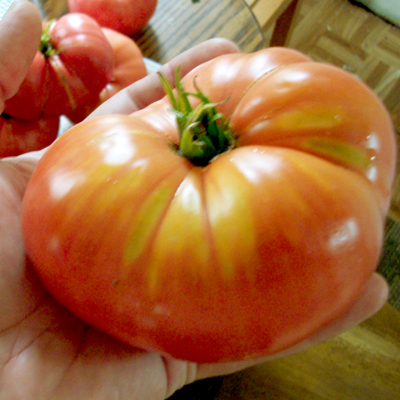
Several years ago a client of mine was purchasing his first home. This was late November or early December, and although we had no snow on the ground there had been sufficient freezing to kill all of the annual plants. Upon walking from the alley into the backyard I found myself in a jungle of trellises, pots, and brick paths. The entire backyard had been set with paving stones in paths wide enough to get a walker or wheelchair through, and the edges of all of the paths were lined with pots, which before the freezing, had been full of everything from flowers, herbs and tomatoes. I noted that there were well over a dozen 15 gallon pots with large cages in them with frozen out tomatoes drooping like sad water balloons and my client related a story that the real estate agent had told him. The woman who used to live here had grow tomato plants every year, gifting plants to her neighbors, and with her gone several people had bemoaned the fact that they would not get tomato plants any more. Hearing this, I went back to my truck, got a container, and collected a few of the deflated frozen tomatoes. I told my client that I would try growing them to see if it was just some commercial hybrid or if it was something special.
I took the tomatoes home, finished thawing and fermented them, cleaned the seeds, dried them, and then planted them in a flat. The plants were all identical so I knew it was an OP tomato. I gave my client a bunch of plants, and grew a cluster of 5 for myself.
They were absolutely fantastic. The tomato plants first flush of fruits were well over 2# each and seemed to be a brandywine type, but the production was far heavier, and instead of the weak vine type I associate with brandywine plants, these had sturdy upright stems and supported their fruits well. The skins were nearly non-existent on the fruits, and the seeds were all in a single encircling ring of pockets close to the outside edge of the fruit, with the entire interior being solid meat. A slice of it would not turn a sandwich to goo, and the lack of pulp made it a nice processing tomato, though every time I did make a batch of red sauce with them I felt a bit guilty.

I taught my client how to save seeds so that he could share them with his neighbors and keep the strain going in his neighborhood, and I started sharing them online with the circle of gardening fanatics I knew there. Last fall a friend of mine was visiting from DC and talked about the fantastic tomatoes they got from a local famer’s market. Their favorite? Cherokee Purple and Terhune. Even had a box of Terhune tomatoes as the background on their cell phone screen. Small world. This year they are commercially available from Knapps Seeds in Wisconsin. Maybe someday I will start selling them instead of giving plants and seeds away.
There have been questions as to more specific origins, etc. To save myself typing, please refer to and read this thread about the tomato. http://forums.seedsavers.org/showthread.php?t=657


So who is the old woman who grew them originally? Are the tomatoes named after her?
you bugger. I linked the thread at seed savers that goes into that.
I couldn’t agree more. We had a slaiimr conversation with friends at dinner a few weeks ago, about getting back to food basics. I love to cook, I love to shop. However, a couple of years ago when gas prices first went really crazy, and food prices skyrocketed, I found myself getting angry while grocery shopping. That was weird. I was busy like everyone else, and living in California most produce is available year round, be it from Mexico, Chile or Guatamala if I wanted a $4 red pepper in January, I could have one. That was nuts. How big a carbon foot-print does one bell pepper need anyway? My grocery bill also was a bit ridiculous.I didn’t grow up that way though. I grew up going to the local Green Grocer, saw what was in season, and we planned weekly meals based on local, seasonal, availability. I’d done it before, why not now? I’d fallen into the west coast trap of planning weekly meals, then finding the food, not paying attention to price or flavor, to fit the recipe because it’s jetted in from all over the world all year long.In the past I used to complain that organic seasonal produce was over-priced, it was trendy’, and I could never find what I needed’, so I didn’t buy it often. However, the increased costs of transporting foods, at least here, seems have leveled the field. I can now buy organic locally grown produce often for less than market bought produce, support my local farms, and eat flavorful seasonal food. Not the watery tasteless orbs in the grocery store. Basically we’ve come back to common sense. It’s actually exciting looking at the kale or the squash on the market stall and devising a meal based on what’s in front of me. Eventually as we get the gardens going, we hope to grow most of our own. I rarely go to the grocery store any more. I now devise meals around what’s available in season. I’ve branched out a lot with my cooking, the food looks better, tastes better, we’re eating better, and until we can harvest from our own garden, we have a fun Saturday morning farmer’s market field trip every week. Now I figure if we’re not going to eat fresh food we might as well be eating kibble.
How many days to maturity? I can’t go much over 70 here. They sound great!
I’d like to know about the woman too.
Terhune are about 80 days to maturity. I am in Minnesota and it is not an issue for me. If 70 days to maturity is your limit, the Lauerer is more appropriate.
Chicken wire is easy. I do two methods: The first is what you see in the above photo I just wrap the iernte section of containers with a big piece of chicken wire. The second is to fashion chicken wire cloches for individual plants. Both work well but the individual cloches look a lot nicer. That project is in but you can see a that will give you some idea of how I do it.Katje: Depends on where you are. My roof is accessible from the fire escape so that’s how they are getting to the veggies. There are a lot of raccoons around the city but we seem to have a lot of opposums in this area. We suspect the possom is living underneath our fire escape so that doesn’t help!
This guy is correct. I’ve been grwonig tomatoes and peppers for almost a decade, and his advice will save you years of screwing around. If you can afford to not be cheap, don’t be cheap. Make CRW (concrete reinforcement wire ) cages or get the Texas Tomato Cages. CRW cages rust, are hard to store and look like crap after a year or two, but they work well. The Texas Tomato Cages have a high initial cost, but will save you time and money in the long run. Plus, they don’t rust.
Thanks, Hillary. Actually, I do offer a class called Getting the Most Out of Your Home Garden, which talks about bio-intensive/small space gierdnang in both front and back yards. It’s a 3-hour class, offered January-May. If you’re interested in learning more about our classes, you can go to the Classes link at the top of our website!Jorge I’ll try to share pictures throughout the season, and keep you posted as to how the trellising works!
I appreciate your cometnms, as YOUR experience. I disagree with your statements. My tomato plants get 10+ feet tall. Maybe in your climate/soil they dont grow as big. You are right, each person needs to find appropriate staking/ support unique for their particular growing situation. In mine, a stake will not work.